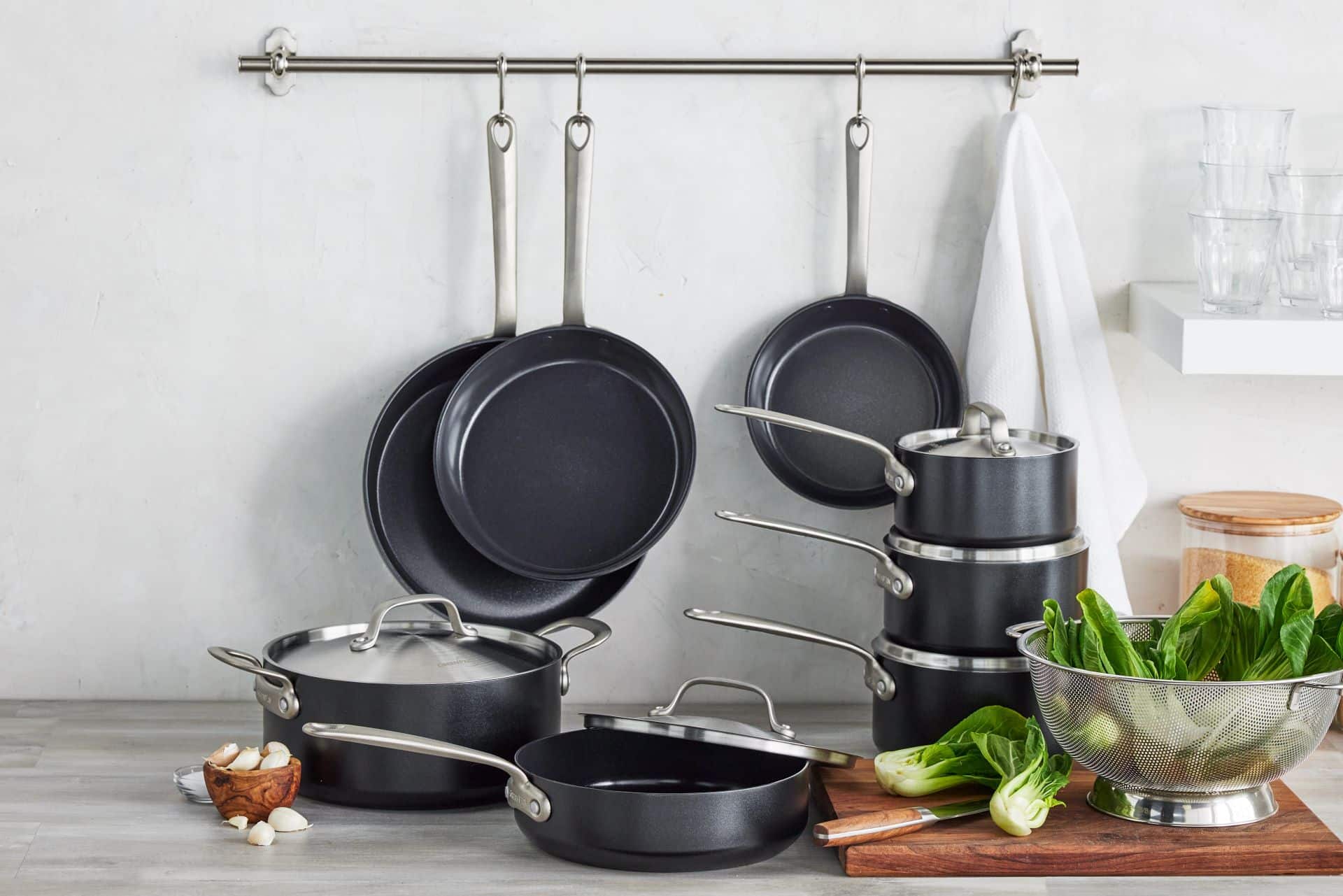Decisions, decisions.


Cooking is an art form that relies not only on skill and creativity, but also on the tools we use in the kitchen. Among the essential tools for any home chef, cookware takes center stage.
From preparing a simple breakfast for your family on a Sunday morning to crafting restaurant-worthy dishes to impress your dinner club friends, the type of cookware you use can greatly impact the taste of dishes, texture of ingredients and your overall cooking experience.
But with an abundance of options available, it can be overwhelming to navigate the world of cookware. If you’re looking to start (or add to) your own cookware collection, it’s important to understand the unique properties, advantages and disadvantages of each type of material, as each brings its own set of characteristics and strengths. The material of your cookware also influences factors such as heat distribution, durability, nonstick properties and even the level of maintenance that’s needed to keep the cookware in tip-top shape.
In this guide, we’ll explore the pros and cons—as well as cleaning and care instructions—of four of the most popular options: stainless steel, nonstick, ceramic nonstick and cast iron. By understanding the distinctions between these materials, you’ll be able to select the best cookware material for your cooking style, preferences and culinary needs.
Hungry for more? With a patented laser-clad titanium nonstick interior that’s durable against scratches and chips and oven-safe up to 600°F, Viking’s new PerformanceTi cookware collection is a must have for any kitchen.
Stainless steel cookware has become a staple in kitchens around the world due to its durability, versatility and timeless appeal. This material is an alloy made of iron, carbon and other metals, with a layer of chromium that provides corrosion resistance. This composition gives it a sturdy and robust structure that can withstand high temperatures and heavy use. Stainless steel cookware often features an aluminum or copper core sandwiched between layers of stainless steel to enhance heat distribution.
Pros
Cons
To clean and care for stainless steel cookware, start by handwashing it with mild dish soap, warm water and a non-abrasive sponge or cloth. Avoid abrasive cleaners, steel wool or harsh scrubbing brushes that can scratch the surface.
For tough stains or discoloration, create a paste using baking soda and water or use a non-abrasive cleaning agent, like Bar Keepers Friend. To prevent dried food from creating a cleaning nightmare, you can also add a bit of vinegar to your hot pan after cooking and bring it to a boil—stuck-on bits should easily come off by scraping with a wooden spoon.
Nonstick cookware has revolutionized the way we cook, providing convenience, easy food release and hassle-free cleanup. Designed with a special coating that prevents food from sticking to the surface, nonstick cookware has become a popular choice for both professional chefs and home cooks alike, well-loved for being one of the best cookware materials for everyday use.
Nonstick cookware typically consists of a metal base, oftentimes aluminum, but can also be made of stainless steel or even copper. It’s then coated with a nonstick material, which creates a smooth, low-friction surface that reduces the chances of food sticking during cooking.
Pros
Cons:
Nonstick cookware is the easiest material to clean—warm soapy water and a non-abrasive brush are typically all that’s needed. For stubborn food particles, soak the cookware in warm, soapy water before scrubbing. Rinse thoroughly with clean water and ensure the cookware is completely dry before storing. Avoid using harsh chemicals or abrasive cleaners, as they can harm the nonstick coating.
Ceramic nonstick cookware has emerged as a popular choice for those seeking a healthier cooking experience without compromising on convenience. This type of cookware features a ceramic-based coating on the cooking surface, providing a smooth and nonstick finish. Ceramic nonstick cookware typically consists of a metal base, such as aluminum or stainless steel, coated with a layer of ceramic. The ceramic coating is typically derived from inorganic materials like silica or sand.
Pros:
Cons:
Similar to nonstick cookware, cleaning ceramic nonstick material is relatively simple. Warm water, soap and a nonabrasive brush or sponge are typically all you’ll need. For stubborn stains or food residue, soak the cookware in warm soapy water before gently scrubbing. Rinse thoroughly and dry completely to prevent water spots or mineral deposits. To maintain the longevity of the ceramic nonstick coating, store the cookware in a dry and well-ventilated area, avoiding stacking or nesting with other cookware.
Cast iron is made by pouring molten iron into a mold, resulting in a durable and heat-retaining cooking surface. It is known for its thick, heavy construction, which helps distribute heat evenly and retain it for extended periods.
Pros:
Cons:
Cast iron is probably the most involved of the cookware materials when it comes to cleaning—which is something to consider as you determine the best cookware option for your needs.
To care for cast iron cookware, you’ll want to clean cast iron with just water and use salt as an abrasive to help clean off any stubborn food bits. For tougher stains or food residues, clean cast iron with mild dish soap and warm water—but note you may need to reseason your cookware to ensure the pan retains its nonstick qualities. Avoid using harsh detergents or abrasive scrubbers that can remove the seasoning.
After washing, it’s also important to dry the cookware completely to prevent rust. Place it on a stovetop over low heat or in an oven for a few minutes to ensure all moisture is evaporated. After drying, apply a thin layer of oil to the cooking surface to maintain the seasoning and prevent rust. Use a cloth or paper towel to distribute the oil evenly.
Choosing the best cookware for your needs involves several factors. Here are a few things to consider to help you make an informed decision:
Hungry for more? With a patented laser-clad titanium nonstick interior that’s durable against scratches and chips and oven-safe up to 600°F, Viking’s new PerformanceTi cookware collection is a must have for any kitchen.
JOIN THE CONVERSATION